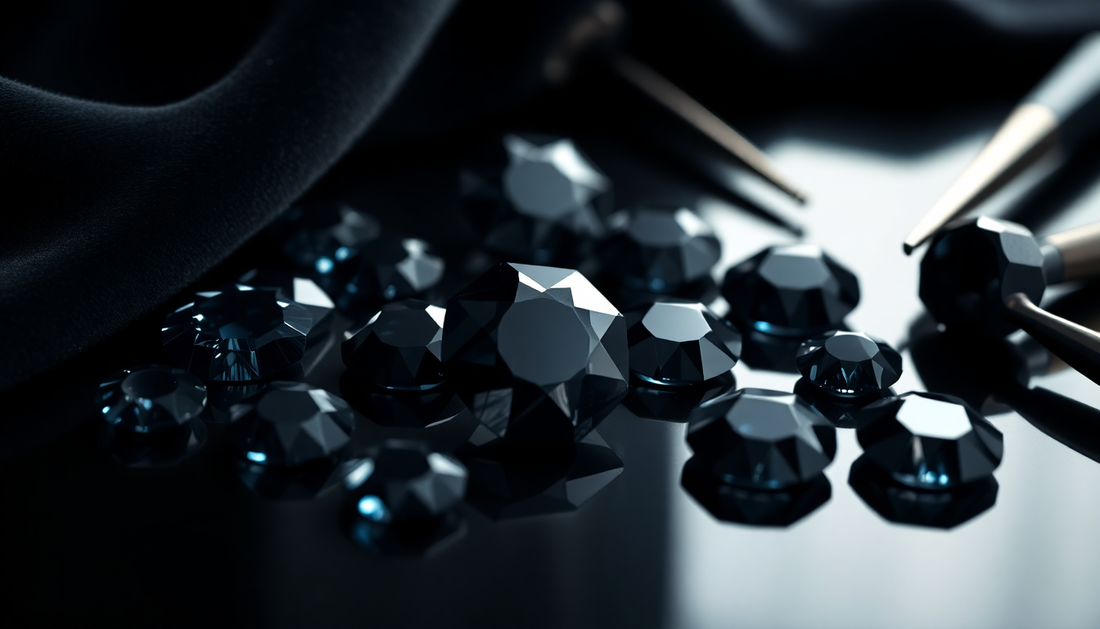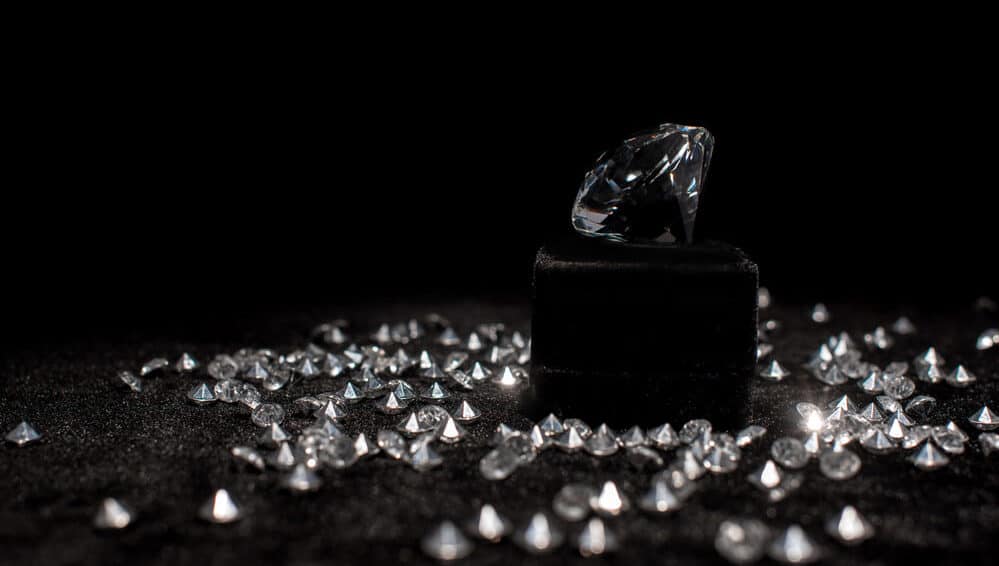Introduction
Black diamonds captivate with their unique allure—deep, inky hues and mysterious brilliance make them stand out. But like all gemstones, they can dull, chip, or accumulate grime over time. Black diamond restoration combines careful cleaning, professional polishing, safe repair, and creative resets to bring back their mesmerizing beauty. This guide explores every aspect—from cleaning tips and expert trade secrets to choosing a jeweler and finalizing the restoration.
What Is a Black Diamond? Understanding Its Unique Nature
- Origins: Natural black diamonds (carbonados) are rare and porous; more commonly, black diamonds encountered in jewelry today are artificially treated to enhance their color.
- Physical properties: Like other diamonds, they’re durable (Mohs hardness = 10) but irregular internal structure makes them more prone to fractures.
- Value difference: Natural ones—especially untreated—command a premium, while treated (irradiated or high-temperature) versions remain popular due to affordability.
Restoration methods differ subtly depending on whether the diamond is treated or natural—but basic principles still apply.
Why Restore a Black Diamond? Common Issues
- Grime and skins oils
- Surface scratches from hard contact
- Chipped corners from accidental impacts
- Dulling of polished facets
- Loose settings or worn prongs
A proper restoration not only enhances sparkle but protects your stone and its setting from long-term damage.
DIY First-Line Clean: Safe Methods at Home
Gentle Ultrasonic Baths
Method: Submerge jewelry in ultrasonic cleaner with mild detergent for 1–2 minutes.
Caution: Avoid frequent use as blacks are naturally porous.
Warm Soapy Cleaning
Method: Soft toothbrush with warm water + dish soap. Clean every facet, rinse thoroughly, then air‑dry.
Safety: Childlike, but effective.
Steam Cleaning
Method: A jeweler’s steam cleaner can be used sparingly—ensure holds and cleaning stock are secure.
Caution: Use low-intensity steam.
Cloth Polishing
Tool: Jeweler’s cloth, microfiber cloth.
Result: Removes surface smudges gently.
These intro steps are great first lines of defense. Deeper restoration, however, requires professional skill.
Professional Restoration: Techniques Jewelers Use
5.1 Precision Ultrasonic/Steam Cleaning
Jewelers combine both, adjusting cycles and detergents to deep-clean without damaging trated blacks.
5.2 Polishing Microscopic Scratches
Diamond-tipped tools can re-polish facets, restoring light reflection and shine.
5.3 Re-cutting or Re-faceting
For deeply scratched or dull stones, a fine re-faceting preserves appearance without losing significant carat weight.
5.4 Chipping & Fracture Repair
Micro-fracture treatments (laser drilling, diffusion fillers) can waterproof chips and restore surface integrity.
5.5 Re-setting
Gemstone may be reset into a protective bezel, upgrade setting, or reinforcement of exposed facets.
Tools & Equipment in a Black Diamond Restoration Workshop
- Ultrasonic cleaners
- High-grade steam-cleaning equipment
- Diamond-cutting wheel, milling machine
- Diamond micro-polishing equipment
- Protective hand gloves and Ultraviolet microscope
- Micro chisel sets, forceps
- Precision timing control belts, polish paste
- Light-blocking black velvet trays
Step-by-Step Restoration Workflow
- Initial inspection: Gemologist grades chips, cracks, setting tightness.
- Photographic documentation: Before and after shots.
- Deep cleaning: Personalized ultrasonic + steam use.
- Polishing: Resetting facets and restoring shine.
- Microscopic re-faceting: If needed.
- Stabilizing chips: Laser muster and filler introduction.
- Re-setting: If unstable, it’s safe to reset.
- Final evaluation: Check for sparkle, color uniformity, setting tightness.
- Certification (optional): Provide documentation and export quality results.
Pricing of Black Diamond Restoration
Costs vary based on severity:
| Service | Price Range (USD) |
|---|---|
| Basic clean & polish | $75 – $150 |
| Minor chip repair | $200 – $400 |
| Re-faceting (partial) | $500 – $1,200 per carat |
| Extensive re-cutting | $1,500 – $3,000+ per carat |
| Re-setting in new mounting | $200 – $500 |
Choosing Your Restoration Specialist: Top Tips
- Seek certified gemologists (GIA, AGS).
- Ask for portfolio, before/after photos.
- Ensure transparent pricing & written agreements.
- Verify insurance.
- Understand warranty and return policy.
- Look for trusted reviews (Google, Yelp).
- Confirm they work specifically with black diamonds.
Pros & Cons of DIY vs Professional Restoration
DIY Pros
- Low cost
- Fast fix for smudges
- Immediate access
DIY Cons
- Risk of damage
- Ineffective on structural issues
- No documentation
Pro Pros
- Deep, expert-level restoration
- Warranty and insurance
- Documentation & certificate
Pro Cons
- Higher cost
- Turnaround time
- Requires shipping or appointment
Preserving Your Black Diamond After Restoration
- Store in soft-lined box
- Clean regularly with gentle soapy water
- Avoid chemicals (chlorine, bleaches, perfumes)
- Remove during exercise or gardening
- Schedule annual professional inspection
Special Considerations for Treatment Type
Treated (Irradiated) Black Diamonds
Porous structure needs gentle handling; avoid rough CLI‐E emissions.
Natural Black Diamonds
Although rare, they’re harder. But deep cracks may need special repair treatment.
Beyond Restoration: Creative Repurposing Ideas
- Resetting into modern pendants
- Upcycling into heirloom family pieces
- Custom bezel or prong mounts
- Matching rings with accent stones or halos
Frequently Asked Questions (FAQ)
Q1. Can black diamonds be re-polished?
Yes—micro-polishing restores facet shine without impacting carat weight drastically.
Q2. Does ultrasonic permanently damage black diamonds?
Not at low power and short intervals—professional oversight recommended.
Q3. How long does restoration take?
Typically 7–21 days, depending on damage and service type.
Q4. Will restoration decrease diamond value?
No—when performed by qualified professionals, it enhances long-term value.
Q5. What if a chip is inside, not on the surface?
Thicker fractures may require micro-laser drilling or replacement faceting.
Advanced Restoration Challenges & Solutions
While standard cleaning and polishing handle most cases, certain damaged black diamonds require more intensive professional restoration—especially treated diamonds with deep fractures or surface wear.
Fracture Filling & Laser Repair
• Fracture filling uses refractive fillers (glass-like substances) to mask visible cracks. As noted in diamond enhancement discussions, this method requires full disclosure and skilled application
• Laser drilling targets black carbon inclusions. Post-drilling, these fractures are often filled and polished to restore structural integrity.
Re-Faceting & Custom Cuts
Extensive surface damage or facet degradation might justify re-faceting. Professional cutters use tools like diamond polishing wheels and lathes to achieve ideal symmetry—while minimizing carat loss.
Surface Texturing & Bevel Adjustments
Some artisan restore techniques involve micro-bevel treatments to smooth rough edges and restore facet definition. This preserves sparkle while boosting durability.
Professional Restoration Workflow Breakdown
A high-end restoration typically follows a meticulous, documented process:
- In-depth assessment: Under magnification and UV light to detect fractures or filled areas
- Pre-cleaning preparation: Remove jewelry setting to isolate the diamond.
- Targeted cleaning: Custom ultrasonic and steam cycles, using mild detergent for treated stones
- Laser/chemotherapy treatment: If fracture filling is needed—professionals ensure full disclosure to clients.
- Re-faceting and polishing: Precision tools restore facets to original or updated design.
- Final polish & inspection: Final aesthetic adjustments, quality checks, and optional certification updates reinforce customer confidence.
- Re-setting & aftercare guidance: Stones are carefully reset and accompanied by cleaning instructions and warranty.
Pricing & Turnaround Comparison
| Restoration Service | Price Range | Turnaround Time |
|---|---|---|
| Basic ultrasonic & polish | $75–$150 | 1–2 days |
| Laser fracture filling | $200–$600 | 3–5 days |
| Re-faceting (partial) | $500–$1,200 per ct | 1–2 weeks |
| Full re-cut & polish | $1,500–$3,000+ per ct | 2–4 weeks |
| Re-setting & bezel reinforcement | $200–$500 | 1 week |
Prices depend on stone treatment, damage depth, and current market rates.
Choosing the Right Restoration Specialist
Prioritize the following when selecting a restoration jeweler:
- Gemological credentials: GIA or AGS certification ensures trusted evaluations.
- Treatment transparency: Ask directly if fracture-filled or treated—and get it noted in writing.
- Portfolio & references: Request before/after photos, especially of black diamonds.
- Insurance & warranty coverage: Confirm safe delivery and return integration.
- Lab partnerships & equipment: Access to fracture-filling labs and high-end polishing tools indicates higher quality service.
Reddit gem discussions often advise against overheated restorations on treated black diamonds — a strong reminder to choose experienced hands
Post-Restoration Care: Protecting Your Investment
Even after full restoration, black diamonds demand ongoing care:
- Regular cleaning with mild soap and soft brushes (avoid abrasives)
- Avoid ultrasonic and steam cleaners if fracture-filled, per IGI caution .
- Remove jewelry during chores or workouts to prevent chips.
- Schedule annual professional check-ups and cleanings.
When Restoration Isn’t Appropriate
In rare cases, restoration may reduce value:
- Untreated natural black diamonds may lose intrinsic “raw” character when re-faceted.
- Over-polishing or excessive carving can devalue these rare specimens.
- Clients should seek appraisals before restoration to understand value impact.
Future Trends in Black Diamond Restoration
Leading-edge techniques are emerging:
- Nano-coatings: Clear, durable layers to protect treated facets from light damage.
- AI-powered assessment tools: Visual scanners help compare stones to digital records.
- Eco-conscious cleaning chemistry: Non-toxic solvents and steam technologies reduce environmental impact.
- Consumer as artisan movement: DIY bead-on sockets for bezel reset; miniature engraving tools for surface tweaks.
Retailers like Black Diamond Equipment are also enhancing gear with lifetime repair warranties—reflecting a broader move toward long-term product care
Restoration vs Resetting: Knowing the Difference
- Restoration focuses on cleaning, repairing, and polishing existing stone.
- Resetting involves creating a brand-new piece around the restored diamond—allowing for style updates (e.g., solitaire to halo; bezel for protection).
Often these services are bundled: restorers polish and prep the stone, then collaborate with designers to produce a new setting.
Case Study: A Natural Black Diamond Heirloom
- Assessment: Small chips noticed under UV.
- Cleaning: Gentle ultrasonic with mild detergent.
- Repair: Laser fracture filling on two facet edges.
- Polishing: Micro re-facet and polish—retains authenticity.
- Re-set: Installed in low-profile bezel ring (white gold), per heirloom tradition.
- Outcome: Heirloom diamond regained modern elegance with structural reinforcement.
Conclusion
Black diamond restoration breathes new life into cherished stones. While regular at-home care offers a quick refresh, deeper issues—from scratches to chips—need professional attention. With expert polishing, re-faceting, and setting repair, these mystical gems can reclaim their vibrant glow and structural integrity. Armed with this guide, you’re ready to approach restoration confidently—knowing when to clean at home, when to visit a jeweler, and how to choose the best specialist for your unique black diamond piece.
Your unique gem deserves nothing less than brilliance restored—inside and out.


